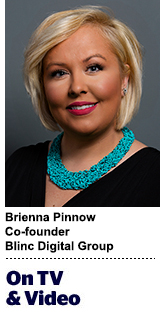
“On TV And Video” is a column exploring opportunities and challenges in advanced TV and video.
Today’s column is written by Brienna Pinnow, co-founder at Blinc Digital Group.
If you’re an advertiser heading into the upfronts, there is a good chance you may be wooed by a new suitor: Facebook.
Why is the TV advertising industry’s annual buying event being infiltrated by a media behemoth known for its digital – not TV – capabilities? The fact that advertisers commit billions of dollars in spend at the upfronts is pretty good motivation.
Beyond that, however, Facebook is aiming to deliver premium, brand-safe content that attracts audiences at scale – we’re talking 100 million viewers. Better yet, it’s hoping to help advertisers reach elusive, ever-growing groups of millennials and cord cutters. During its Facebook Showcase, it will offer reserve-eligible inventory for programs such as Jada Pinkett Smith’s “Red Table Talk.”
At first blush, TV media veterans and enthusiasts may feel like an unwelcome guest has arrived at the party. Remember last year? NBCU’s upfront presentation included direct and indirect jabs at Facebook, including a spoof on the media giant’s congressional hearings.
Jokes aside, if programmers didn’t see FB as a threat, would they have mentioned them at all? Probably not. So if fellow media companies aren’t overly thrilled to have Facebook join the upfronts’ buffet of content, do advertisers feel differently?
Yes – albeit, warily – brands are welcoming Facebook. Instead of relegating the company to the shrinking digital-esque version of the upfronts – the IAB orchestrated NewFronts – brands are leaning in and learning more. Why?
Facebook isn’t rocking the boat. It’s fitting the buying model – offering placements bought in advance at a fixed price. It’s delivering against audiences verified by Nielsen. It’s measuring results in a variety of ways, including Nielsen Digital Ad ratings. It’s ensuring all content is brand-safe and reviewed by humans.
It’s talking the talk. But should advertisers be so sure Facebook is walking the walk? My recommendation is that advertisers take several steps in their approach to leveraging Facebook’s Showcase program.
Demand transparency: If a brand is going to throw down CPMs of around $25 for “premium content,” they must ensure they’re not getting a mixed bag of inventory that could be considered less than traditional TV network quality.
Negotiate price: One of the benefits of the upfronts to advertisers is that in exchange for their commitment, they often receive a price break. That same negotiation lever should be part of advertisers’ Facebook conversations. Similarly, Facebook may need to reset its own expectations of the CPMs it can and should command.
Reset targeting expectations: When marketers think digital, they think data-rich targeting options. Surprisingly, Facebook’s targeting for this inventory is limited to age, gender and a handful of high-level contextual options. Gasp – no addressability? Be prepared to plan Facebook alongside traditional TV campaigns.
Use a slice of your TV budget: Most advertisers use their social media budgets to invest in Facebook. For brands looking to lock in video inventory ahead of schedule and use traditional TV targeting and measurement methodologies, they should consider moving the dollars from their TV budgets instead. This will ensure “big blue” is held to similar standards as other TV investments. That leads to my next point …
Measure, measure, measure: More traditional brand recall measurement options are available with FB. But since it is a digital experience, push Facebook to deliver as many insights and digital metrics in addition to those standard TV KPIs. Traditional TV networks are stepping up their measurement game, such as linear TV campaign measurement that links ad exposure to geolocation data to track in-store visits and other metrics. In this converging world of TV and digital, insights should also be converging – not focused only on TV nor solely on digital.
Dip your toe in the water: Early adopters claim to see positive results, but you have to remember that this is video, not necessarily TV. Start slowly and follow best practices.
As Facebook looks to maneuver its way from Silicon Valley to Madison Avenue, it’s important for both TV sellers and buyers to be aware of Facebook’s premium video capabilities. The audience attention it commands is undeniable.
And if advertisers hold Facebook to the same standards they have for other media partners, they won’t have to renege their upfront invitation in 2020.
Follow AdExchanger (@adexchanger) on Twitter.
This post was syndicated from Ad Exchanger.


More Stories
Mindshare wins IKEA account for NZ
John Deere Seeks a ‘Chief Tractor Officer’ to Be the Face of Its TikTok Channel
Campari unveils new bottle design at Auckland event